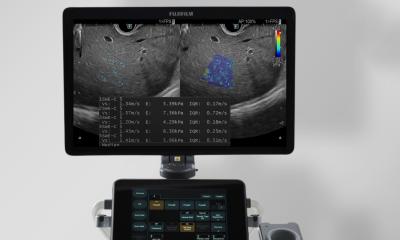Butterfly Network
MRI and Ultrasound via hand-helds?
Venture capitalists are betting $100 million that an entrepreneur can develop an inexpensive and portable imaging device that can be used by office-based physicians.
There’s a serious effort, funded by venture capitalists, to create a compact medical imaging device with the capabilities to disrupt the existing radiology profession. Developers intend to create a more accurate imaging technology that also costs much less than the expensive imaging systems in common use today.
Biomedical entrepreneur Jonathan Rothberg aims to create a new hand-held medical imaging device that can make MRI and ultrasounds significantly cheaper and more efficient, reported Wired magazine. Rothberg is founder of the Butterfly Network, Inc. His goal is to make it possible for office-based physicians to use a point-of-care imaging tool that costs just a couple hundred dollars. It might also help patients in poor regions of the world gain access to imaging tests and better healthcare.
Pathologists and medical laboratory professionals may want to track the development of this device. That’s because this imaging technology might eventually find applications in anatomic pathology.
Investors Are Banking on Emerging Technology
Butterfly Network has raised more than $100 million in funding toward its mission to transform medical imaging and non-invasive surgery. It wants to leverage advances in semiconductors, deep learning, and cloud computing, according to a Butterfly Network news release.
Investors reportedly include Rothberg (who ponied up $20 million) and Stanford University. The money will be used to create a medical imaging device “as cheap as a stethoscope and make doctors 100 times as effective,” declared Rothberg in an interview with Technology Review.
The device’s technology relies on a new kind of ultrasound chip. According to patent documents, this ultrasound chip could eventually contribute to new ways to destroy cancer cells with heat or deliver information to brain cells.
Technology Review called the company’s plans “the largest bet yet on an emerging technology in which ultrasound emitters are etched directly onto a semiconductor wafer alongside circuits and processors.”
Hand-held Device to Diagnose Cancer in Doctor’s Office
Here’s how the ultrasound-on-a-chip technology will be used, Wired reported:
1) A doctor or provider will create a medical image by following on-screen instructions similar to Apple’s Panorama snapshot tool;
2) A compact ultrasound scanner will create 3D images in real time;
3) Images will be sent to a cloud service, which will zoom in on identifying characteristics in the images and help automate diagnoses; and,
4) The service could look at an ultrasound and notify doctors that a baby has Down syndrome or a cleft lip.
In addition to visualizing a fetus, the device will make it possible to diagnose breast cancer, Rothberg told Technology Review.
Company Aims to Improve Access to Healthcare
Telemedicine is expected to be integrated into Butterfly Network’s ultrasound rendition. That will give caregivers in remote areas access to the images recorded by the instrument, Wired reported. More details on what the device looks like and how it works are expected in about 18 months—the length of time apparently required to build the prototype.
One expert envisions the device “disrupting” the clinical market.“Because of its performance and price points, you’ll be disrupting the clinical marketplace, and that’s always a risky undertaking. We think the benefits are so great the company (Butterfly Network) will be able to overcome that,” stated Greg Rehm of Aegis Capital in an interview with Forbes.
Ongoing technological advances in chip design, software, and other related fields are what make it possible for Rothberg and his team to believe they can create a hand-held imaging device that can be more accurate than existing systems, yet cost much less. These same advances, when combined with new capabilities rooted in nano-scale design and miniaturization, will similarly create opportunities for entrepreneurs to design medical laboratory analyzers that move lab testing out of core labs and closer to the patient.
Source: Donna Marie Pocius, www.darkdaily.com
23.02.2015











